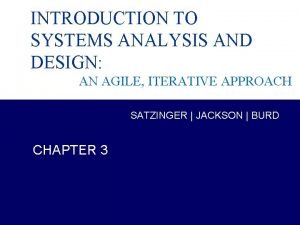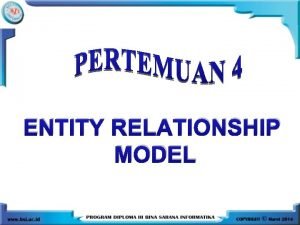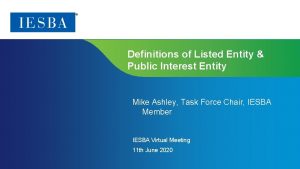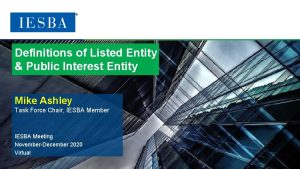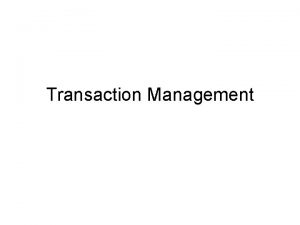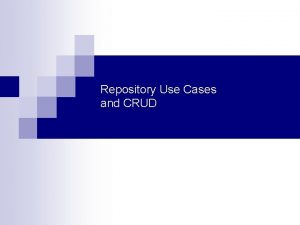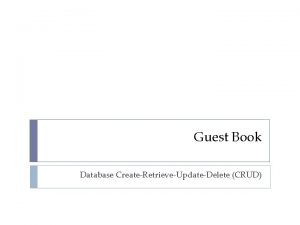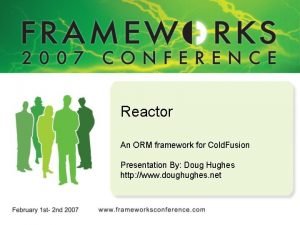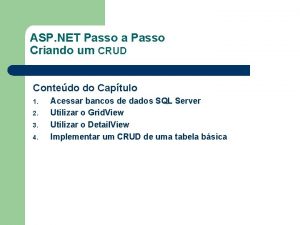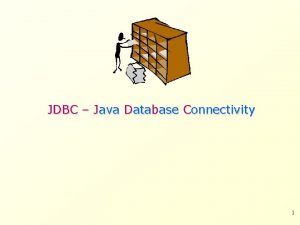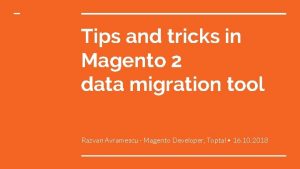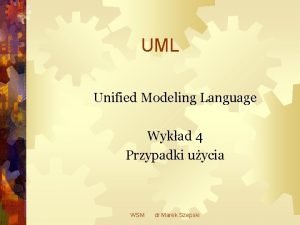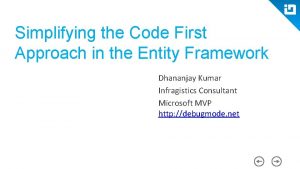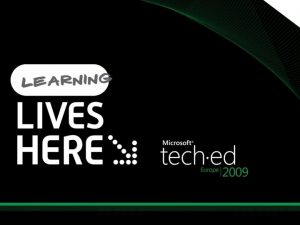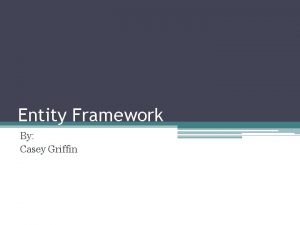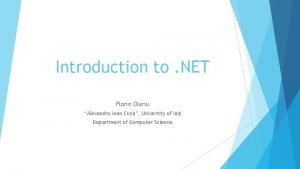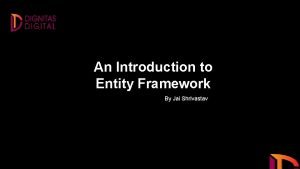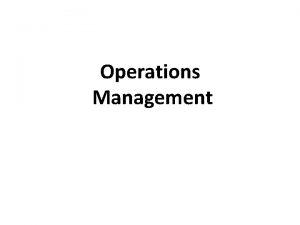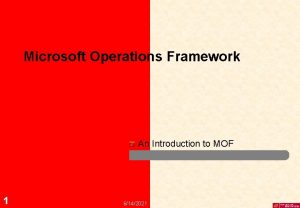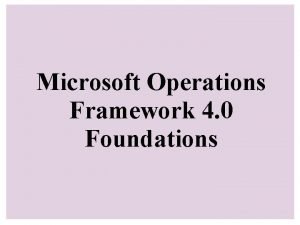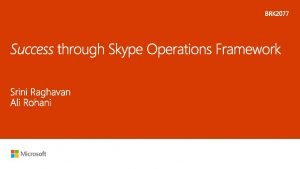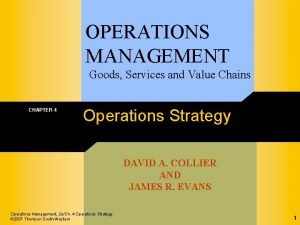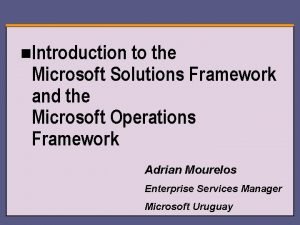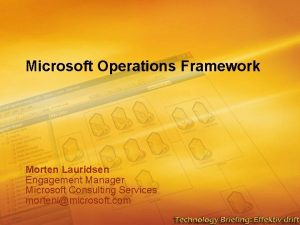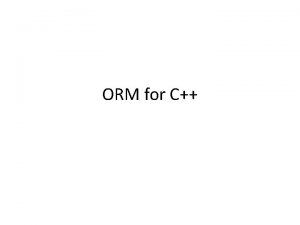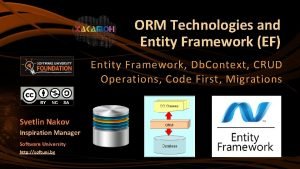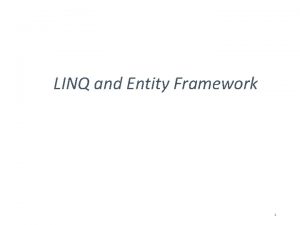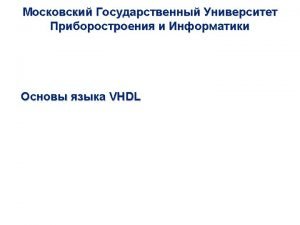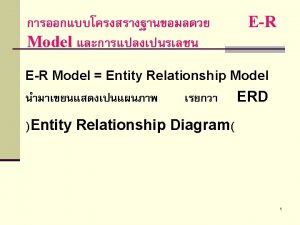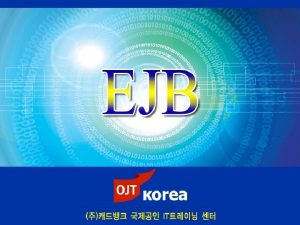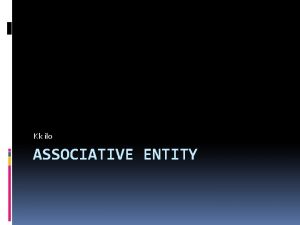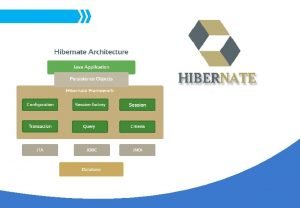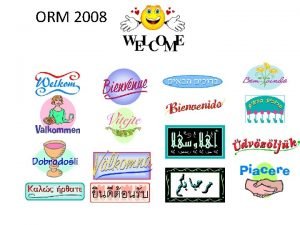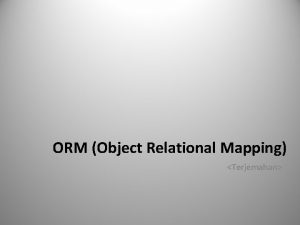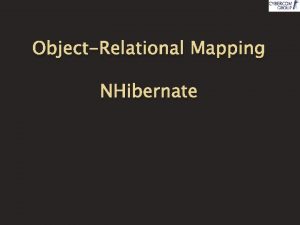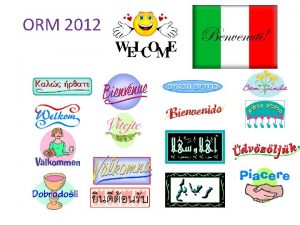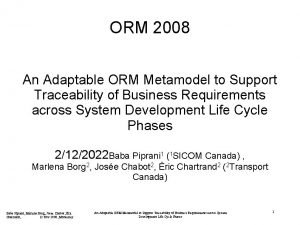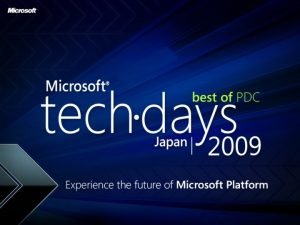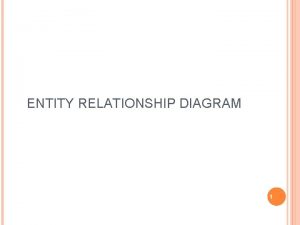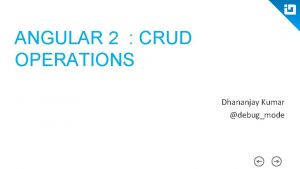Introduction to Entity Framework ORM Concepts CRUD Operations































- Slides: 31

Introduction to Entity Framework ORM Concepts, CRUD Operations Entity Framew or Soft. Uni Team Technical Trainers Software University http: //softuni. bg k SQL

Table of Contents 1. ORM Technologies – Basic Concepts 2. Entity Framework – Overview 3. Reading Data with EF 4. CRUD Operations Using Entity Framework 5. Working with LINQ 2

Questions sli. do #Entity 3

Introduction to ORM Object-Relational Mapping

ORM Frameworks § Object-Relational Mapping (ORM) is a programming technique for automatic mapping of data and schema § Creates a "virtual object database" for the programming language § ORM frameworks automatically generate SQL to perform data operations § ORM frameworks typically provide the following functionality: § Creating object model by database schema (DB first model) § Creating database schema by object model (code first model) § Querying data by object-oriented API (e. g. LINQ queries) 5

ORM Advantages and Disadvantages § Object-relational mapping (ORM) advantages § Developer productivity: writing less code § Abstract from differences between object and relational world § Manageability of the CRUD operations for complex relationships § Easier maintainability § Disadvantages: § Reduced performance (due to overhead or incorrect ORM use) § Reduces flexibility (some operations are hard for implementing) 6

Entity Framework Overview and Features

Overview and Features § Entity Framework (EF) is the standard ORM framework for. NET § Integrated with Visual Studio § Provides LINQ-based data queries and CRUD operations § Automatic change tracking of in-memory objects § Works with any relational database § Open source with independent release cycle github. com/aspnet/Entity. Framework 8

EF: Basic Workflow 1. Define the data model (use a DB Visual designer or code first) 2. Write & execute query over IQueryable 3. EF generates & executes an SQL query in the DB 9

EF: Basic Workflow (2) 4. EF transforms the query results into. NET objects 5. Modify data with C# code and call "Save Changes" 6. Entity Framework generates & executes SQL command to modify the DB 10

Entity Framework in Visual Studio § To add EF support to a project in Visual Studio: § Select Add New Item… from the project's context menu Chose "From Database" Select ADO. NET 11

Entity Framework in Visual Studio (2) Pick server Select after creating Pick database 12

EF Components § The Db. Context class § Db. Context holds the database connection and the entity classes § Provides LINQ-based data access § Implements identity tracking, change tracking, and API for CRUD operations § Entity classes § Hold entities (objects with their attributes and relations) § Each database table is typically mapped to a single C# entity class 13

EF Components (2) § Associations (relationship mappings) § An association is a primary key / foreign key-based relationship between two entity classes § Allows navigation from one entity to another var courses = student. Courses. Where(…); § Concurrency control § Entity Framework uses optimistic concurrency control § No locking by default § Automatic concurrency conflict detection 14

Reading Data Querying the DB using Entity Framework

The Db. Context Class § The Db. Context class is generated by the Visual Studio designer § Db. Context provides: § Methods for accessing entities (object sets) § Methods for creating new entities (Add() methods) § Ability to manipulate database data though entity classes § Read, modify, delete, insert § Easily navigate through the table relationships § Executing LINQ queries as native SQL queries § Create the DB schema in the database server 16

Using Db. Context Class § First create instance of the Db. Context: var soft. Uni. Entities = new Soft. Uni. Entities(); § In the constructor you can pass a database connection string and mapping source § Db. Context properties: § Connection – the Sql. Connection to be used § Command. Timeout – SQL commands execution timeout in the DB § All entity classes (tables) are listed as properties § e. g. IDb. Set<Employee> Employees { get; } 17

Reading Data with LINQ Query § Executing LINQ-to-Entities query over EF entity: using (var context = new Soft. Uni. Entities()) { var employees = from e in context. Employees where e. Job. Title == "Design Engineer" select e; } This will be translated to an SQL query by EF § Employees property in the Db. Context: public partial class Soft. Uni. Entities : Db. Context { public IDb. Set<Employee> Employees { get; set; } public IDb. Set<Project> Projects { get; set; } public IDb. Set<Department> Departments { get; set; } } 18

Reading Data with LINQ Query § We can also use extension methods for constructing the query using (var context = new Soft. Uni. Entities()) { var employees = context. Employees. Where(c => c. Job. Title == "Design Engineering"). Select(c => c. First. Name). To. List(); This is called projection } § Find element by id To. List() method executes the query using (var context = new Soft. Uni. Entities()) { var project = context. Projects. Find(2); Console. Write. Line(project. Name); } 19

LINQ: Simple Operations § Where() § Searches by given condition § First() / First. Or. Default() § Gets the first matched element § Last() / Last. Or. Default() § Gets the last matched element § Select() § Makes projection (conversion) to another type § Order. By() / Then. By() / Order. By. Descending() § Orders a collection 20

LINQ: Simple Operations (2) § Any() § Checks if any element matches a condition § All() § Checks if all elements match a condition § Distinct() § Returns only the unique elements § Skip() / Take() § Skips or takes X number of elements 21

Logging the Native SQL Queries § Printing the native database SQL command behind a query: var query = context. Employees; Console. Write. Line(query. To. String()); § Queries can be monitored with Express Profiler https: //expressprofiler. codeplex. com/ 22

CRUD Operations With Entity Framework

Creating New Data § To create a new database row use the method Add(…) of the corresponding collection: Create a new project object var project = new Project() { Name = "Judge System", Start. Date = new Date. Time(2015, 4, 15), }; Mark the object for inserting context. Projects. Add(project); context. Save. Changes(); Execute SQL statement 24

Cascading Inserts § We can also add cascading entities to the database: Employee employee = new Employee(); employee. First. Name = "Petya"; employee. Last. Name = "Grozdarska"; employee. Projects. Add(new Project { Name = "Soft. Uni Conf"} ); soft. Uni. Entities. Employees. Add(employee); soft. Uni. Entities. Save. Changes(); § The Project will be added when the Employee entity (employee) is inserted to the database 25

Updating Existing Data § Db. Context allows modifying entity properties and persisting them in the database § Just load an entity, modify it and call Save. Changes() § The Db. Context automatically tracks all changes made on its entity objects Employees employee = soft. Uni. Entities. Employees. First(); employees. First. Name = "Alex"; context. Save. Changes(); This will execute an SQL SELECT to load the first order an SQL UPDATE 26

Deleting Existing Data § Delete is done by Remove() on the specified entity collection § Save. Changes() method performs the delete action in the database Employees employee = soft. Uni. Entities. Employees. First(); Mark the entity for deleting at the next save soft. Uni. Entities. Employees. Remove(employee); soft. Uni. Entities. Save. Changes(); This will execute the SQL DELETE command 27

Summary § ORM frameworks map database schema to objects in a programming language § Entity Framework is the standard. NET ORM § LINQ can be used to query the DB var employees = context. Employees. Where(c => c. Job. Title == "Design Engineering"). Select(c => c. First. Name). To. List(); 28

Introduction to Entity Framework ? s n stio e u Q ? ? ? https: //softuni. bg/courses/

License § This course (slides, examples, demos, videos, homework, etc. ) is licensed under the "Creative Commons Attribution. Non. Commercial-Share. Alike 4. 0 International" license § Attribution: this work may contain portions from § "Databases" course by Telerik Academy under CC-BY-NC-SA license

Free Trainings @ Software University § Software University Foundation – softuni. org § Software University – High-Quality Education, Profession and Job for Software Developers § softuni. bg § Software University @ Facebook § facebook. com/Software. University § Software University Forums § forum. softuni. bg
 Crud operations
Crud operations Contoh partial participation
Contoh partial participation Contoh strong entity dan weak entity
Contoh strong entity dan weak entity Public interest entity vs listed entity
Public interest entity vs listed entity Public interest entity
Public interest entity Crud transactions
Crud transactions Use case diagram crud
Use case diagram crud Pengertian crud
Pengertian crud Coldfusion crud example
Coldfusion crud example Crud asp.net c# web forms
Crud asp.net c# web forms How jdbc works
How jdbc works Magento tips and tricks
Magento tips and tricks Language
Language Orm hazard definition
Orm hazard definition Entity framework code first
Entity framework code first Entity framework 4
Entity framework 4 Entity framework disadvantages
Entity framework disadvantages Entity framework core
Entity framework core Entity framework 7 release date
Entity framework 7 release date Key concepts in operations management
Key concepts in operations management Mof microsoft
Mof microsoft Microsoft operations framework
Microsoft operations framework Skype operations framework
Skype operations framework Hills strategy development framework
Hills strategy development framework Microsoft solutions framework
Microsoft solutions framework Microsoft operations framework
Microsoft operations framework Dispositional framework vs regulatory framework
Dispositional framework vs regulatory framework Theoretical framework example
Theoretical framework example Conceptual framework maker
Conceptual framework maker Conceptual framework theoretical framework
Conceptual framework theoretical framework Dispositional framework vs regulatory framework
Dispositional framework vs regulatory framework Theoretical framework example
Theoretical framework example
